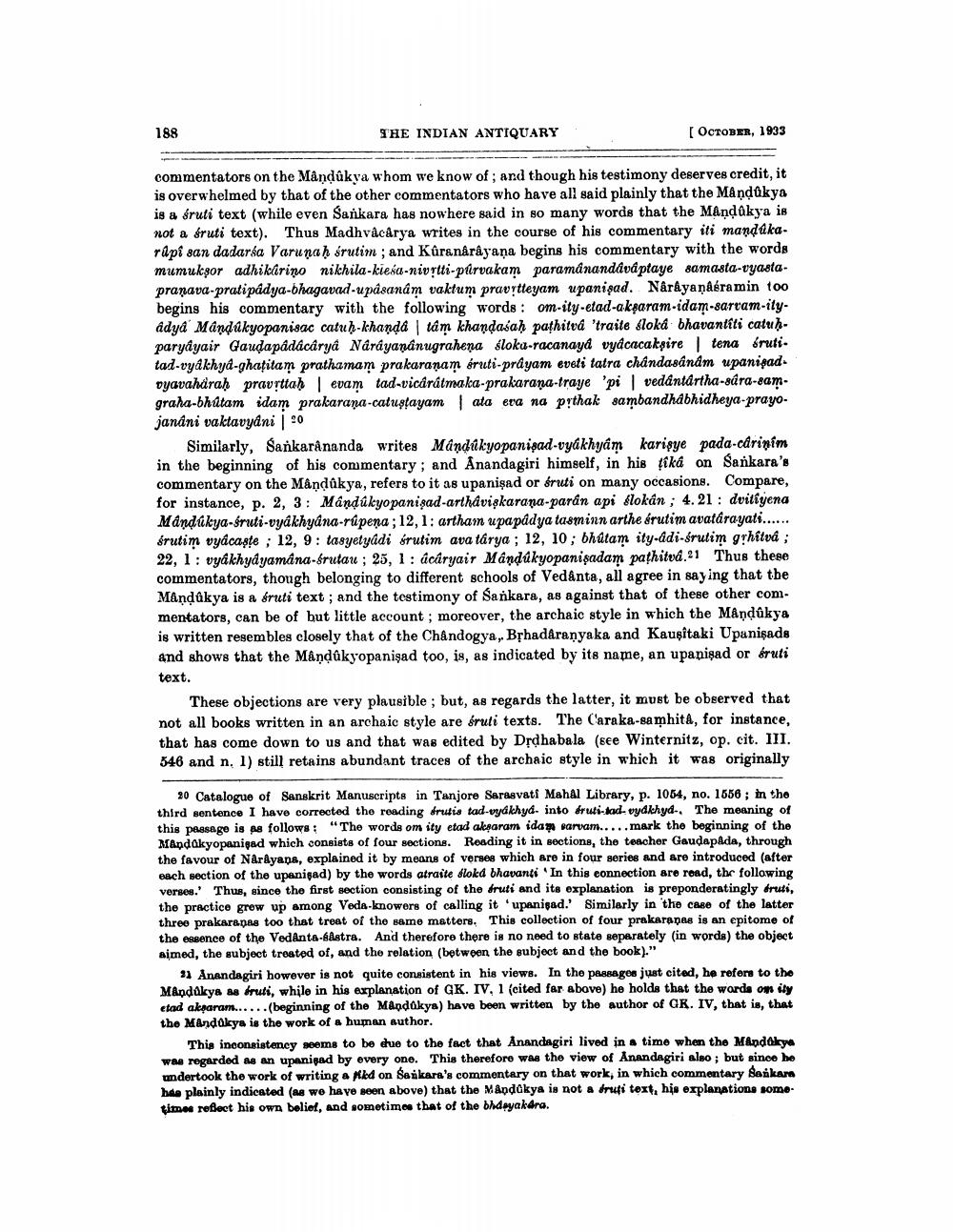________________
188
THE INDIAN ANTIQUARY
[OCTOBER, 1933
commentators on the Mândûkya whom we know of; and though his testimony deserves credit, it is overwhelmed by that of the other commentators who have all said plainly that the Mandokya is a śruti text (while even Sankara has nowhere said in so many words that the Mandúkya is not a fruti text). Thus Madhvâcârya writes in the course of his commentary iti mandika. rūpi san dadarśa Varunaḥ śrutim; and Kûranârâyana begins his commentary with the words mumuksor adhikarino nikhila-kieka-nivștti-ptirvakam paramånandåváptaye samasta-vyastapranava-prati pádya-bhagavad-upâsanam vaktum pravrtteyam upanigad. Nåråyaņdéramin too begins his commentary with the following words : om-ity-etad-aksaram-idam-sarram-ityadya Mandukyopanisac catuh-khanda | tâm khandasah pathitva 'traite sloka bhavantiti catuh. paryayair Gauda padácârya Narayanánugrahena sloka-racanayd vydcacakşire tena bruti. tad-vyakhyd-ghatitam prathamam prakaranam fruti-pråyam eveti tatra chándasândm upanigad. dyavaharaḥ pravýttah evam tad-vicárátmaka-prakarana-traye 'pi vedantartha-sára-samgraha-bhatam idam prakarana-catustayam ata era na pythak sambandhabhidheya-prayojanani vaktavyäni 0
Similarly, Sankarananda writes Mandukyopanisad-vyakhyam karisye pada-carinim in the beginning of his commentary; and Anandagiri himself, in his fika on Sankara's commentary on the Måndükya, refers to it as upanişad or sruti on many occasions. Compare, for instance, p. 2, 3: Mandukyopanişad-arthåviskarana-paran api flokán; 4.21: dvitsyena Mandúkya-sruti-vyakhyana-rupena ; 12, 1: artham upapád ya tasminn arthe érutim avatarayati...... śrutim vyácaste ; 12, 9: tasyetyádi frutim ava tarya ; 12, 10; bhutam ity-adi-śrutim gyhítvá ; 22, 1 : vyakhydyamâna-brutau ; 25, 1: acáryair Mandukyopanişadam pathitvd.21 Thus these commentators, though belonging to different schools of Vedanta, all agree in saying that the Måndükya is a fruti text; and the testimony of Sankara, as against that of these other commentators, can be of but little account, moreover, the archaic style in which the Mandûkya is written resembles closely that of the Chåndogya, BȚhadaranyaka and Kausitaki Upanişads and shows that the Mândûkyopanişad too, is, as indicated by its name, an upanişad or éruti text.
These objections are very plausible; but, as regards the latter, it must be observed that not all books written in an archaic style are sruti texts. The C'araka-samhita, for instance, that has come down to us and that was edited by Drdhabala (see Winternitz, op. cit. III. 546 and n. 1) still retains abundant traces of the archaic style in which it was originally
20 Catalogue of Sanskrit Manuscripts in Tanjore Sarasvati Mahal Library, p. 1064, no. 1656 ; in the third sentence I have corrected the reading drutis tad-vyákhyd. into frutikad. vydlhyd-. The meaning of this passage is as follows: "The words om ity etad aksaram idam sarvam.....mark the beginning of the Mandakyopanigad which consists of four sections. Reading it in sections, the teacher GaudapAda, through the favour of Nardyans, explained it by means of verses which are in four series and are introduced (after each section of the upanişad) by the words atraite flokd bhavanti 'In this eonnection are read, the following verses.' Thus, since the first section consisting of the fruti and its explanation is preponderatingly fruti, the practico grow up among Veda-knowers of calling it 'upanipad. Similarly in the case of the latter three prakaranas too that treat of the same matters. This collection of four prakaranas is an epitome of the essence of the VedAnta-Alatra. And therefore there is no need to state separately (in words) the object aimed, the subject treated of, and the relation (between the subject and the book)."
31 Anandagiri however is not quite consistent in his views. In the passages just cited, he refers to the Måndkys as bruti, while in his explanation of GK. IV, 1 (cited for above) he holds that the words on ity etad akşaram......(beginning of the Mandukys) have been written by the author of GR. IV, that is, that the Mandokya is the work of a human author.
This inconsistency seems to be due to the fact that Anandagiri lived in a time when the MAndokya was regarded as an upanipad by every one. This therefore was the view of Anandagiri also; but since he undertook the work of writing a Mad on Seikara's commentary on that work, in which commentary Sankar he plainly indicated (as we have seen above) that the Mandokya is not a fruti toxt, his explanations some times reflect his own beliet, and sometimes that of the bhdayakdra.




